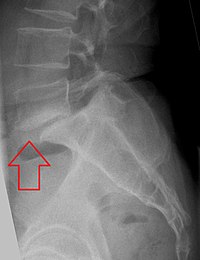
Photo from wikipedia
PurposeThe aim of the study was to evaluate the efficacy and safety of the direct lateral approach to the lumbar spine in the treatment of painful isthmic spondylolisthesis in adults.MethodsTwenty-one… Click to show full abstract
PurposeThe aim of the study was to evaluate the efficacy and safety of the direct lateral approach to the lumbar spine in the treatment of painful isthmic spondylolisthesis in adults.MethodsTwenty-one patients affected by isthmic spondylolisthesis and treated with extreme lateral interbody fusion and posterior percutaneous pedicle screw fixation were enrolled. All included patients were clinically evaluated with Oswestry Disability Index, SF36 and Visual Scale Anatomy (VAS) for back pain at 1, 3 months and at 1 year.ResultsThe mean correction of vertebral slippage measured on lateral lumbar X-ray was 56.3% (p = 0.002). The average preoperative VAS score was 7.1, at 1 year decreasing to 2.2 (p = 0.001). The patients had an average preoperative “Oswestry Disability Index” of 36.8 and 24.1% after 1 year (p = 0.02). The preoperative Short-Form 36 Physical Health was equal to 33.8, 72.1% after 1 month, to 76.3% after 3 months and to 83.2% (p = 0.001) after 1 year of follow-up. There were no signs of implant loosening at 1-year CT scan examination in any of the patients.ConclusionThe study showed that the extreme lateral approach to the lumbar spine in case of isthmic spondylolisthesis is a reliable and safe option to the most common open procedures. In the authors’ opinion, XLIF procedures allow a good correction of the listhesis associated with good clinical and radiographic results.Graphical abstractThese slides can be retrieved under Electronic supplementary material.
Journal Title: European Spine Journal
Year Published: 2018
Link to full text (if available)
Share on Social Media: Sign Up to like & get
recommendations!